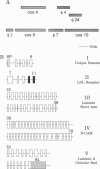Abstract
The complete intron-exon organization of the gene encoding human perlecan (HSPG2), the major heparan sulfate proteoglycan of basement membranes, has been elucidated, and specific exons have been assigned to coding sequences for the modular domains of the protein core. The gene was composed of 94 exons, spanning > 120 kbp of genomic DNA. The exon arrangement was analyzed vis-à-vis the modular structure of the perlecan, which harbors protein domains homologous to the low density lipoprotein receptor, laminin, epidermal growth factor, and neural cell adhesion molecule. The exon size and the intron phases were highly conserved when compared to the corresponding domains of the homologous genes, suggesting that most of this modular proteoglycan has evolved from a common ancestor by gene duplication or exon shuffling. The 5' flanking region revealed a structural organization characteristic of housekeeping and growth control-related genes. It lacked canonical TATA or CAAT boxes, but it contained several GC boxes with binding sites for the transcription factors SP1 and ETF. Consistent with the lack of a TATA element, the perlecan gene contained multiple transcription initiation sites distributed over 80 bp of genomic DNA. These results offer insights into the evolution of this chimeric molecule and provide the molecular basis for understanding the transcriptional control of this important gene.
Full text
PDF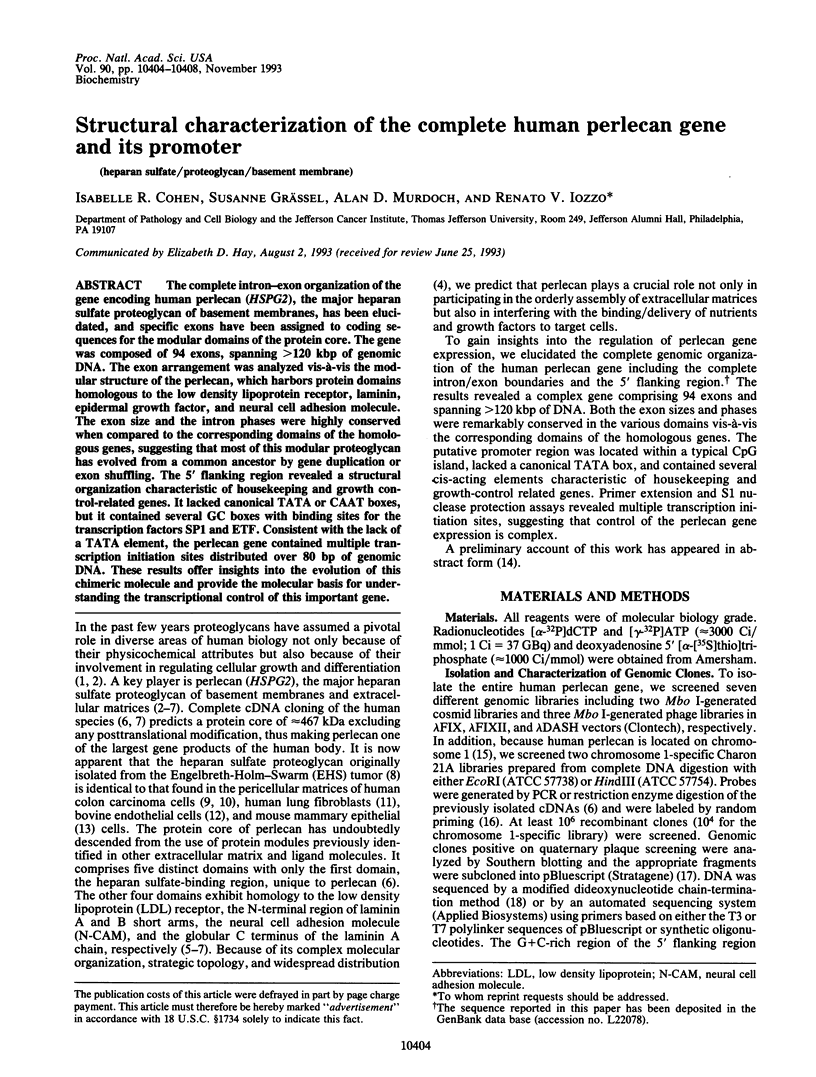
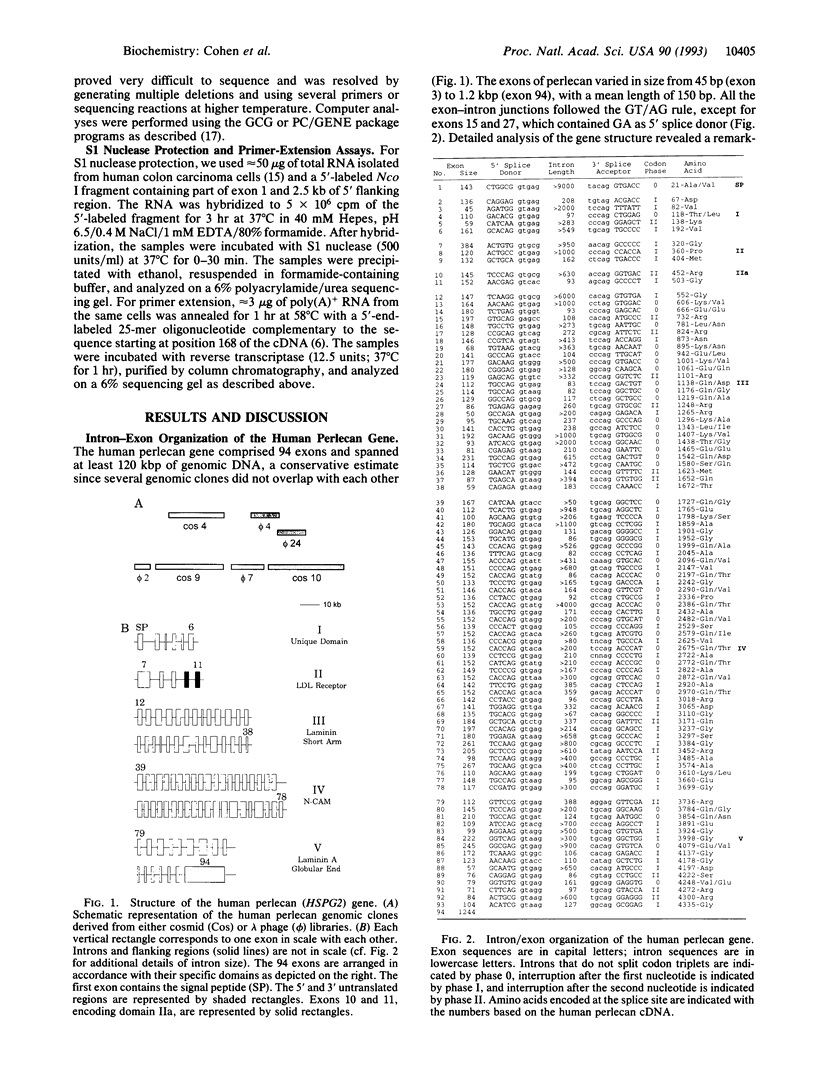
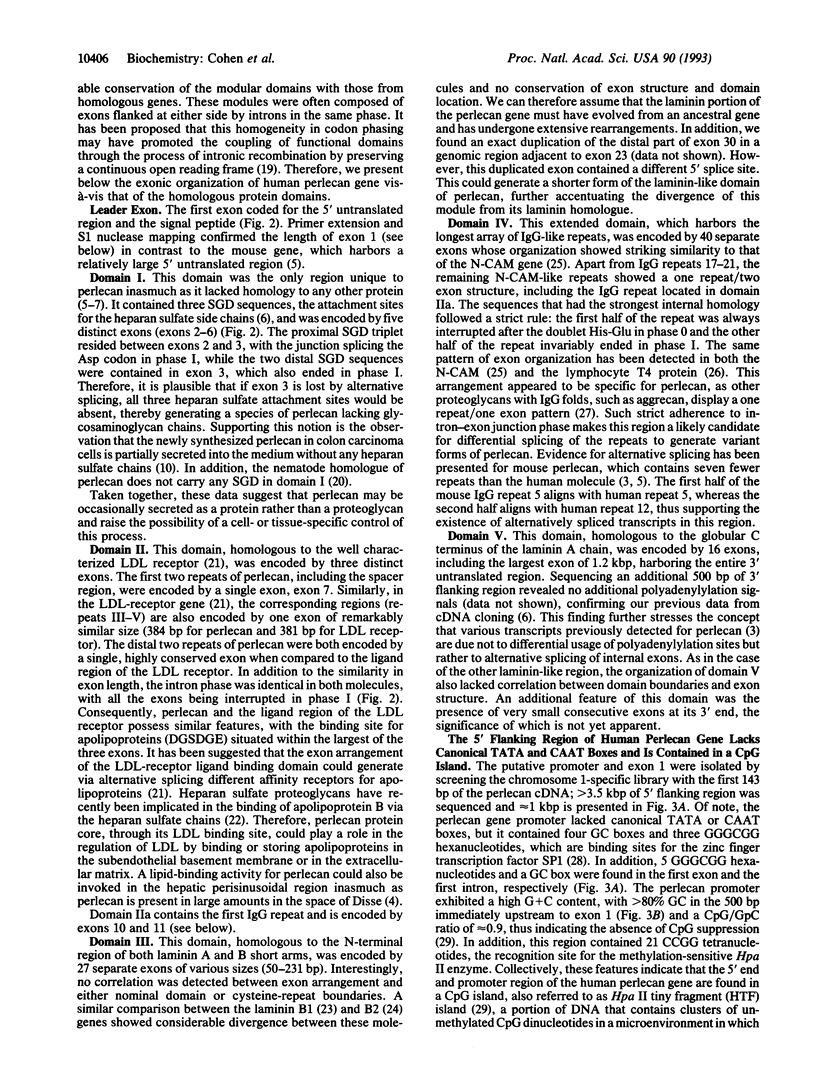
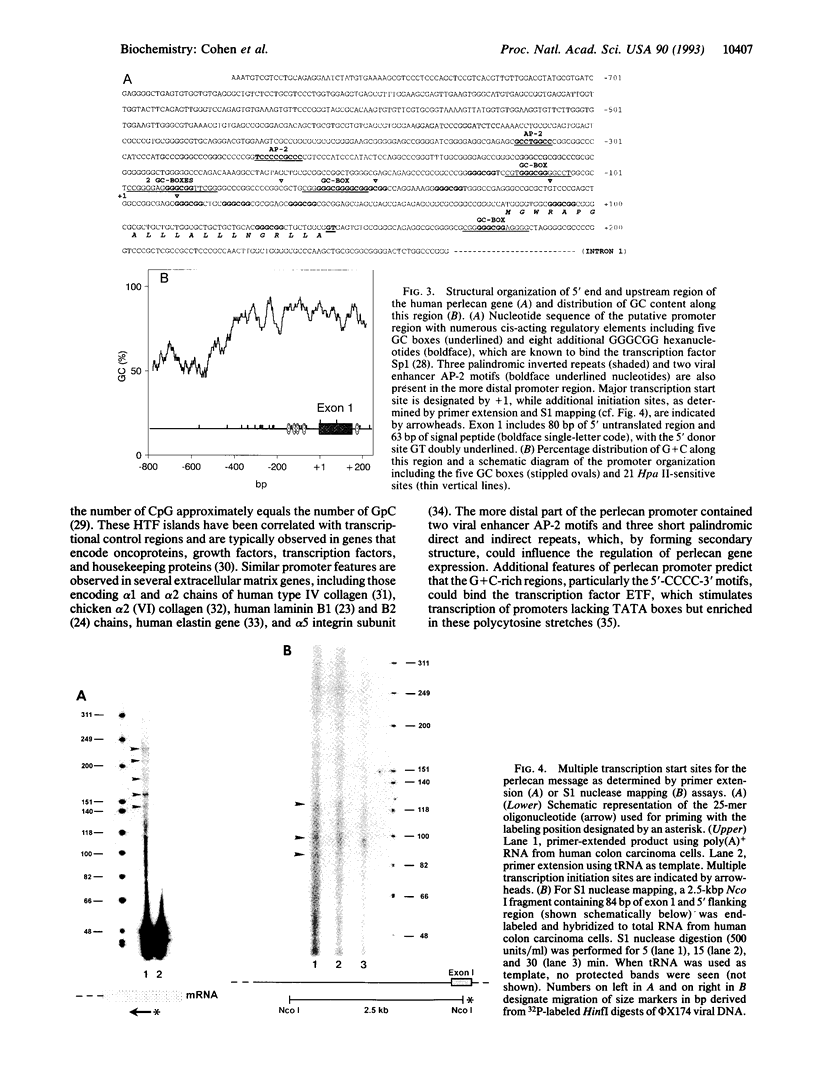
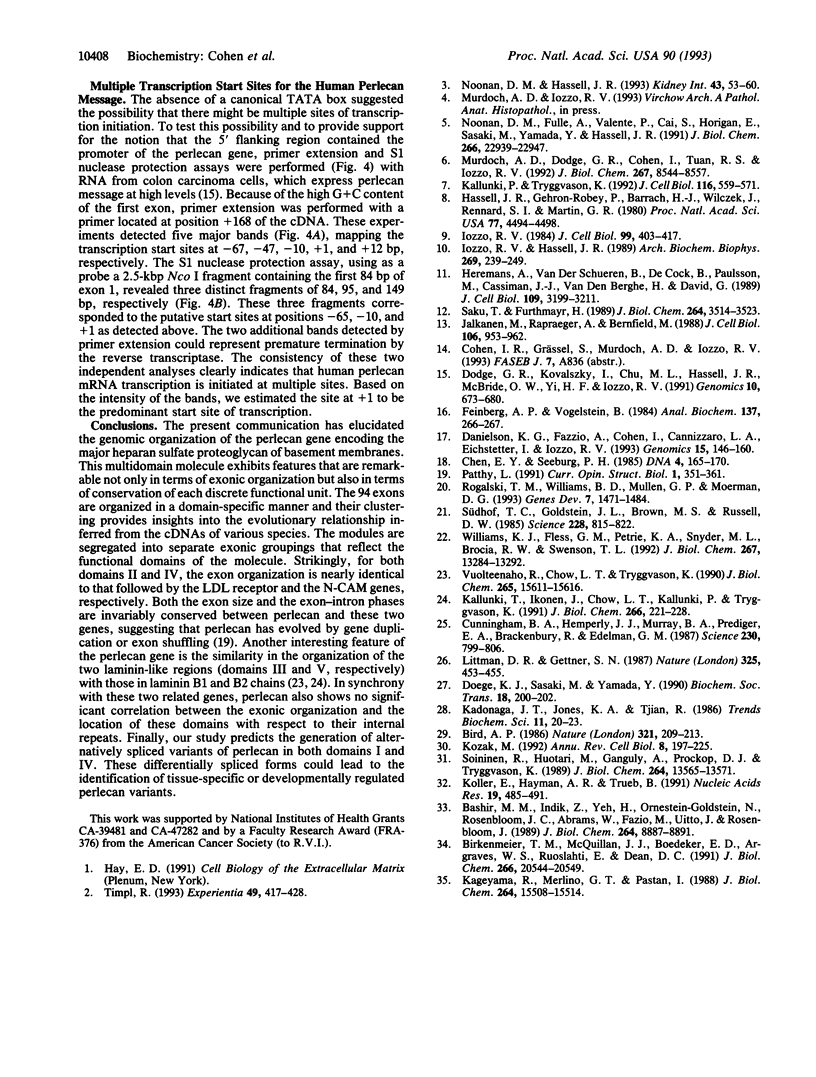
Images in this article
Selected References
These references are in PubMed. This may not be the complete list of references from this article.
- Bashir M. M., Indik Z., Yeh H., Ornstein-Goldstein N., Rosenbloom J. C., Abrams W., Fazio M., Uitto J., Rosenbloom J. Characterization of the complete human elastin gene. Delineation of unusual features in the 5'-flanking region. J Biol Chem. 1989 May 25;264(15):8887–8891. [PubMed] [Google Scholar]
- Bird A. P. CpG-rich islands and the function of DNA methylation. Nature. 1986 May 15;321(6067):209–213. doi: 10.1038/321209a0. [DOI] [PubMed] [Google Scholar]
- Birkenmeier T. M., McQuillan J. J., Boedeker E. D., Argraves W. S., Ruoslahti E., Dean D. C. The alpha 5 beta 1 fibronectin receptor. Characterization of the alpha 5 gene promoter. J Biol Chem. 1991 Oct 25;266(30):20544–20549. [PubMed] [Google Scholar]
- Chen E. Y., Seeburg P. H. Supercoil sequencing: a fast and simple method for sequencing plasmid DNA. DNA. 1985 Apr;4(2):165–170. doi: 10.1089/dna.1985.4.165. [DOI] [PubMed] [Google Scholar]
- Cunningham B. A., Hemperly J. J., Murray B. A., Prediger E. A., Brackenbury R., Edelman G. M. Neural cell adhesion molecule: structure, immunoglobulin-like domains, cell surface modulation, and alternative RNA splicing. Science. 1987 May 15;236(4803):799–806. doi: 10.1126/science.3576199. [DOI] [PubMed] [Google Scholar]
- Danielson K. G., Fazzio A., Cohen I., Cannizzaro L. A., Eichstetter I., Iozzo R. V. The human decorin gene: intron-exon organization, discovery of two alternatively spliced exons in the 5' untranslated region, and mapping of the gene to chromosome 12q23. Genomics. 1993 Jan;15(1):146–160. doi: 10.1006/geno.1993.1022. [DOI] [PubMed] [Google Scholar]
- Dodge G. R., Kovalszky I., Chu M. L., Hassell J. R., McBride O. W., Yi H. F., Iozzo R. V. Heparan sulfate proteoglycan of human colon: partial molecular cloning, cellular expression, and mapping of the gene (HSPG2) to the short arm of human chromosome 1. Genomics. 1991 Jul;10(3):673–680. doi: 10.1016/0888-7543(91)90451-j. [DOI] [PubMed] [Google Scholar]
- Doege K., Sasaki M., Yamada Y. Rat and human cartilage proteoglycan (aggrecan) gene structure. Biochem Soc Trans. 1990 Apr;18(2):200–202. doi: 10.1042/bst0180200. [DOI] [PubMed] [Google Scholar]
- Feinberg A. P., Vogelstein B. "A technique for radiolabeling DNA restriction endonuclease fragments to high specific activity". Addendum. Anal Biochem. 1984 Feb;137(1):266–267. doi: 10.1016/0003-2697(84)90381-6. [DOI] [PubMed] [Google Scholar]
- Hassell J. R., Robey P. G., Barrach H. J., Wilczek J., Rennard S. I., Martin G. R. Isolation of a heparan sulfate-containing proteoglycan from basement membrane. Proc Natl Acad Sci U S A. 1980 Aug;77(8):4494–4498. doi: 10.1073/pnas.77.8.4494. [DOI] [PMC free article] [PubMed] [Google Scholar]
- Heremans A., van der Schueren B., de Cock B., Paulsson M., Cassiman J. J., van den Berghe H., David G. Matrix-associated heparan sulfate proteoglycan: core protein-specific monoclonal antibodies decorate the pericellular matrix of connective tissue cells and the stromal side of basement membranes. J Cell Biol. 1989 Dec;109(6 Pt 1):3199–3211. doi: 10.1083/jcb.109.6.3199. [DOI] [PMC free article] [PubMed] [Google Scholar]
- Iozzo R. V. Biosynthesis of heparan sulfate proteoglycan by human colon carcinoma cells and its localization at the cell surface. J Cell Biol. 1984 Aug;99(2):403–417. doi: 10.1083/jcb.99.2.403. [DOI] [PMC free article] [PubMed] [Google Scholar]
- Iozzo R. V., Hassell J. R. Identification of the precursor protein for the heparan sulfate proteoglycan of human colon carcinoma cells and its post-translational modifications. Arch Biochem Biophys. 1989 Feb 15;269(1):239–249. doi: 10.1016/0003-9861(89)90105-7. [DOI] [PubMed] [Google Scholar]
- Jalkanen M., Rapraeger A., Bernfield M. Mouse mammary epithelial cells produce basement membrane and cell surface heparan sulfate proteoglycans containing distinct core proteins. J Cell Biol. 1988 Mar;106(3):953–962. doi: 10.1083/jcb.106.3.953. [DOI] [PMC free article] [PubMed] [Google Scholar]
- Kageyama R., Merlino G. T., Pastan I. Nuclear factor ETF specifically stimulates transcription from promoters without a TATA box. J Biol Chem. 1989 Sep 15;264(26):15508–15514. [PubMed] [Google Scholar]
- Kallunki P., Tryggvason K. Human basement membrane heparan sulfate proteoglycan core protein: a 467-kD protein containing multiple domains resembling elements of the low density lipoprotein receptor, laminin, neural cell adhesion molecules, and epidermal growth factor. J Cell Biol. 1992 Jan;116(2):559–571. doi: 10.1083/jcb.116.2.559. [DOI] [PMC free article] [PubMed] [Google Scholar]
- Kallunki T., Ikonen J., Chow L. T., Kallunki P., Tryggvason K. Structure of the human laminin B2 chain gene reveals extensive divergence from the laminin B1 chain gene. J Biol Chem. 1991 Jan 5;266(1):221–228. [PubMed] [Google Scholar]
- Koller E., Hayman A. R., Trueb B. The promoter of the chicken alpha 2(VI) collagen gene has features characteristic of house-keeping genes and of proto-oncogenes. Nucleic Acids Res. 1991 Feb 11;19(3):485–491. doi: 10.1093/nar/19.3.485. [DOI] [PMC free article] [PubMed] [Google Scholar]
- Kozak M. Regulation of translation in eukaryotic systems. Annu Rev Cell Biol. 1992;8:197–225. doi: 10.1146/annurev.cb.08.110192.001213. [DOI] [PubMed] [Google Scholar]
- Littman D. R., Gettner S. N. Unusual intron in the immunoglobulin domain of the newly isolated murine CD4 (L3T4) gene. 1987 Jan 29-Feb 4Nature. 325(6103):453–455. doi: 10.1038/325453a0. [DOI] [PubMed] [Google Scholar]
- Murdoch A. D., Dodge G. R., Cohen I., Tuan R. S., Iozzo R. V. Primary structure of the human heparan sulfate proteoglycan from basement membrane (HSPG2/perlecan). A chimeric molecule with multiple domains homologous to the low density lipoprotein receptor, laminin, neural cell adhesion molecules, and epidermal growth factor. J Biol Chem. 1992 Apr 25;267(12):8544–8557. [PubMed] [Google Scholar]
- Noonan D. M., Fulle A., Valente P., Cai S., Horigan E., Sasaki M., Yamada Y., Hassell J. R. The complete sequence of perlecan, a basement membrane heparan sulfate proteoglycan, reveals extensive similarity with laminin A chain, low density lipoprotein-receptor, and the neural cell adhesion molecule. J Biol Chem. 1991 Dec 5;266(34):22939–22947. [PubMed] [Google Scholar]
- Noonan D. M., Hassell J. R. Perlecan, the large low-density proteoglycan of basement membranes: structure and variant forms. Kidney Int. 1993 Jan;43(1):53–60. doi: 10.1038/ki.1993.10. [DOI] [PubMed] [Google Scholar]
- Rogalski T. M., Williams B. D., Mullen G. P., Moerman D. G. Products of the unc-52 gene in Caenorhabditis elegans are homologous to the core protein of the mammalian basement membrane heparan sulfate proteoglycan. Genes Dev. 1993 Aug;7(8):1471–1484. doi: 10.1101/gad.7.8.1471. [DOI] [PubMed] [Google Scholar]
- Saku T., Furthmayr H. Characterization of the major heparan sulfate proteoglycan secreted by bovine aortic endothelial cells in culture. Homology to the large molecular weight molecule of basement membranes. J Biol Chem. 1989 Feb 25;264(6):3514–3523. [PubMed] [Google Scholar]
- Soininen R., Huotari M., Ganguly A., Prockop D. J., Tryggvason K. Structural organization of the gene for the alpha 1 chain of human type IV collagen. J Biol Chem. 1989 Aug 15;264(23):13565–13571. [PubMed] [Google Scholar]
- Südhof T. C., Goldstein J. L., Brown M. S., Russell D. W. The LDL receptor gene: a mosaic of exons shared with different proteins. Science. 1985 May 17;228(4701):815–822. doi: 10.1126/science.2988123. [DOI] [PMC free article] [PubMed] [Google Scholar]
- Timpl R. Proteoglycans of basement membranes. Experientia. 1993 May 15;49(5):417–428. doi: 10.1007/BF01923586. [DOI] [PubMed] [Google Scholar]
- Vuolteenaho R., Chow L. T., Tryggvason K. Structure of the human laminin B1 chain gene. J Biol Chem. 1990 Sep 15;265(26):15611–15616. [PubMed] [Google Scholar]
- Williams K. J., Fless G. M., Petrie K. A., Snyder M. L., Brocia R. W., Swenson T. L. Mechanisms by which lipoprotein lipase alters cellular metabolism of lipoprotein(a), low density lipoprotein, and nascent lipoproteins. Roles for low density lipoprotein receptors and heparan sulfate proteoglycans. J Biol Chem. 1992 Jul 5;267(19):13284–13292. [PubMed] [Google Scholar]



